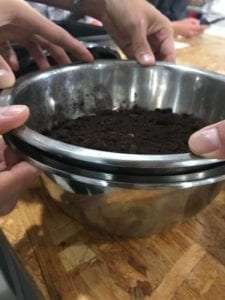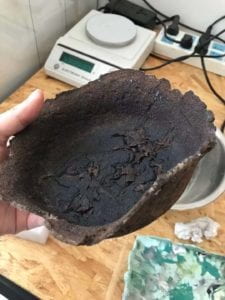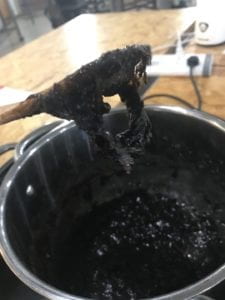Bioplastics Experiments
In class, Ben, Kenneth and I tried out the used coffee grounds recipe. We realized a bit after we mixed all the ingredients that Professor Marcela had mentioned that the recipe called for a bit too much used coffee grounds, so we added an extra 50ml of water and 2-5ml of agar agar to try and balance everything out.
It was then poured into a large metal bowl as a mold, with another bowl on top.

I checked back on it this past Monday and was surprised to see it was still wet. Professor Marcela suggested putting it in the dryer, which, after about a day of drying looked like this:

Still needs to dry, though!
I decided to experiment more with the used coffee grounds, with different ratios of ingredients. Before I saw the drying result I thought that the reason it was so wet and jelly-like was because we put too much water. For the second experiment, the ingredients were:
- 15 ml agar agar
- 5 ml glycerol
- 250 ml water
- 5 ml alginate
- 0.3 cups coffee grounds
This time the mixture seemed to be a lot thicker and clumpier as I was stirring it all together. I poured it into one of the small tins. It still needs to dry, but after about 17 hours of drying it looks like this:

I still had a lot of the mixture left over and didn’t want to waste it all, so I poured in 20 ml of water to try and get rid of some of the clumpiness. This seemed to make it super jelly-like as it dried a bit:

I poured this mixture into a plastic cup I had, and after about 17 hours of drying it looks like this:

Final Project Ideas
Idea 1: Reconstructed Waimai Packaging
The convenience of waimai has made it extremely popular in Shanghai. One of the problems with it, however, is the amount of waste that is produced from all of the food packaging. Services like eleme have already made steps toward trying to reduce this waste, such as making it mandatory for you to specify whether or not you need single-use disposable tableware. What if we could reduce the waste further through packaging created from bioplastics?
Idea 2: Sleeves for hot drinks at the cafe
When you order a hot drink from our school’s cafe, it comes with a cardboard sleeve so that your hand doesn’t get hot. We’ve already made progress in reducing cafe waste through the reusable metal cups, but what about the sleeves? The sleeves could potentially be created out of plastic waste using the molding techniques we have learned, but I’m wondering if there needs to be some sort of coating to prevent the hot drink from altering it.
Leave a Reply